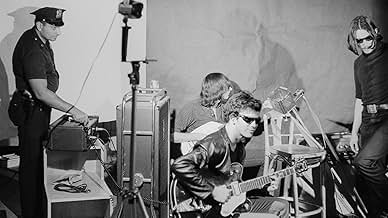Adicionar um enredo no seu idiomaThe film depicts the first band practice of The Velvet Underground and Nico at the Factory in New York in January 1966, and is essentially one long loose improvisation.The film depicts the first band practice of The Velvet Underground and Nico at the Factory in New York in January 1966, and is essentially one long loose improvisation.The film depicts the first band practice of The Velvet Underground and Nico at the Factory in New York in January 1966, and is essentially one long loose improvisation.
Enredo
Você sabia?
- ConexõesFeatured in Warhol's Cinema 1963-1968: Mirror for the Sixties (1989)
Avaliação em destaque
I believe this film has some good things going for it, but within narrow parameters. So I will try to define those, as I see them, and you can decide to make the effort to see it yourself (or not).
The screening I went to was greatly enhanced (in my opinion) by an introduction by Nico's biographer, who had also interviewed everybody appearing in the film. He explained that, when Warhol had been persuaded to take on the management of a nightclub and a rock band (that band being the Velvet Underground), one of the first things he did was get Nico onboard as a lead singer. Another thing he did was decide to have some film projected behind the band as they were performing onstage. To that end, he filmed them jamming vanilla footage of about seventy minutes. This is what this film was intended for.
Now it will appeal to die-hard Velvet Underground fans cos if you are a fan you can never get enough of your favourite band. But casual listeners might not be quite so thrilled. You probably know a track called Sister Ray - this is a song by the band that has a few opening lyrics and then a long (instrumental) jam session. Well, if you were to cut out the lyrics and extended the jam for over an hour that's more or less what you've got here. No famous songs. No-one sings in it. But the Velvet Underground brand of jamming can get quite hypnotic. If you're in the mood (with or without drugs) you can probably dig it and really get into it.
A second group it might appeal to is those people who are interested in film history either professionally or from a deep interest in film. If you think of the original remit (a backing film for a live performance) and think how much money and techno-wizardry would probably be expended on that today, and then look at this . . . Well I think you might agree that it is very effective at very little cost. Watching it in the originally intended setting would be exceedingly cool. Much better than a film of them doing specific tracks (which might clash with the onstage stuff) or something technically complicated (which would possibly distract). It was a good idea that could perhaps usefully be employed by band promoters today. It gives a whole new dimension to the idea of a music video, and a very simple one at that.
A third group it will appeal to is dedicated Warhol fans and historians. How often do you get a chance to glimpse inside one of his workplaces? This film is shot in his first 'Factory' and is a nice down-and-dirty view, complete with police walking in towards the end to get them to turn the noise down (following complaints from neighbours). You can have fun spotting the various personalities and also maybe (as I did) comparing the camera techniques with those used in Chelsea Girls.
I don't see it really appealing to anyone else, but I may have missed something. At any rate, this is minimalist film at its best, exploring technique in the 60's when there was so much waiting to be explored and Warhol was determined to explore (and exploit) it. I admired and enjoyed it. A lot of people didn't.
The screening I went to was greatly enhanced (in my opinion) by an introduction by Nico's biographer, who had also interviewed everybody appearing in the film. He explained that, when Warhol had been persuaded to take on the management of a nightclub and a rock band (that band being the Velvet Underground), one of the first things he did was get Nico onboard as a lead singer. Another thing he did was decide to have some film projected behind the band as they were performing onstage. To that end, he filmed them jamming vanilla footage of about seventy minutes. This is what this film was intended for.
Now it will appeal to die-hard Velvet Underground fans cos if you are a fan you can never get enough of your favourite band. But casual listeners might not be quite so thrilled. You probably know a track called Sister Ray - this is a song by the band that has a few opening lyrics and then a long (instrumental) jam session. Well, if you were to cut out the lyrics and extended the jam for over an hour that's more or less what you've got here. No famous songs. No-one sings in it. But the Velvet Underground brand of jamming can get quite hypnotic. If you're in the mood (with or without drugs) you can probably dig it and really get into it.
A second group it might appeal to is those people who are interested in film history either professionally or from a deep interest in film. If you think of the original remit (a backing film for a live performance) and think how much money and techno-wizardry would probably be expended on that today, and then look at this . . . Well I think you might agree that it is very effective at very little cost. Watching it in the originally intended setting would be exceedingly cool. Much better than a film of them doing specific tracks (which might clash with the onstage stuff) or something technically complicated (which would possibly distract). It was a good idea that could perhaps usefully be employed by band promoters today. It gives a whole new dimension to the idea of a music video, and a very simple one at that.
A third group it will appeal to is dedicated Warhol fans and historians. How often do you get a chance to glimpse inside one of his workplaces? This film is shot in his first 'Factory' and is a nice down-and-dirty view, complete with police walking in towards the end to get them to turn the noise down (following complaints from neighbours). You can have fun spotting the various personalities and also maybe (as I did) comparing the camera techniques with those used in Chelsea Girls.
I don't see it really appealing to anyone else, but I may have missed something. At any rate, this is minimalist film at its best, exploring technique in the 60's when there was so much waiting to be explored and Warhol was determined to explore (and exploit) it. I admired and enjoyed it. A lot of people didn't.
- Chris_Docker
- 2 de out. de 2007
- Link permanente
Principais escolhas
Faça login para avaliar e ver a lista de recomendações personalizadas
Detalhes
- Tempo de duração1 hora 10 minutos
- Cor
- Mixagem de som
Contribua para esta página
Sugerir uma alteração ou adicionar conteúdo ausente

Principal brecha
By what name was The Velvet Underground and Nico (1966) officially released in Canada in English?
Responda
























